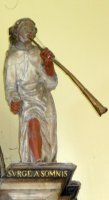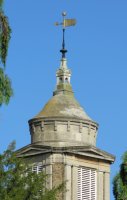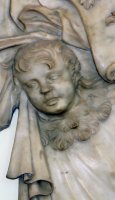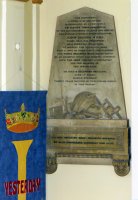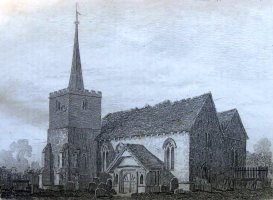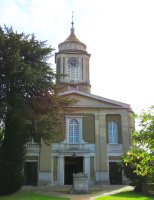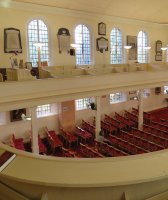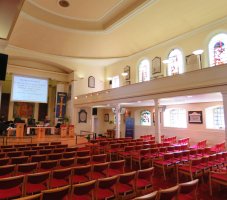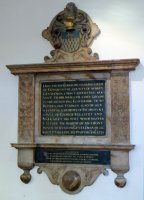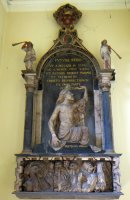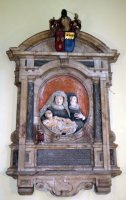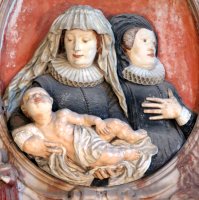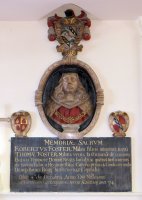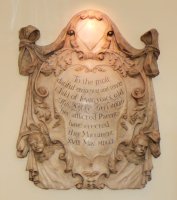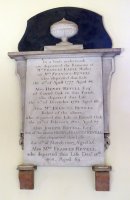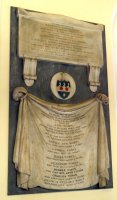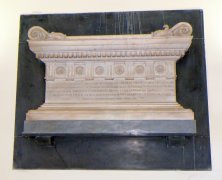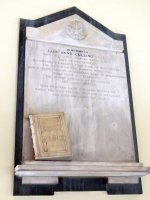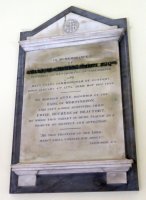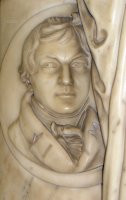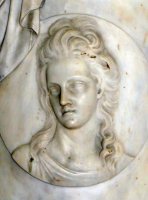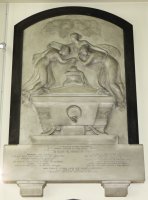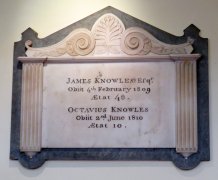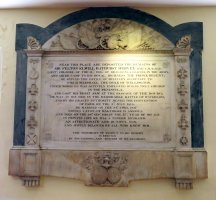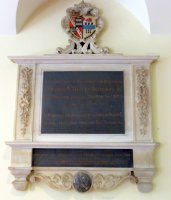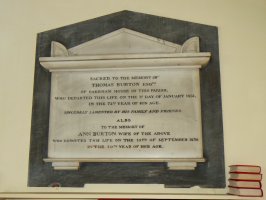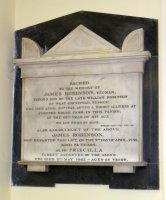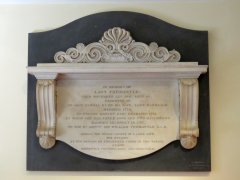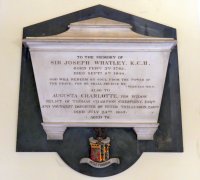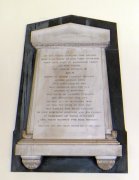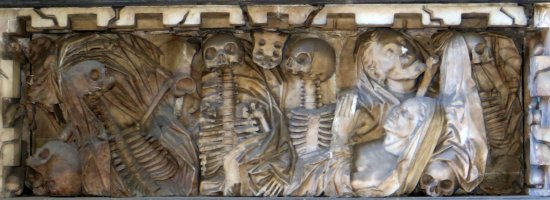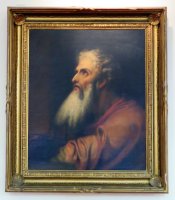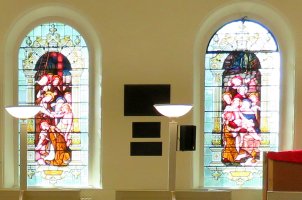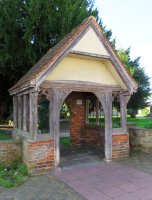Egham Church monuments
Egham Church, just south west of Heathrow Airport within Surrey, contains around three dozen panel monuments, with a few early pieces and a good crop of 19th Century white-on-black pieces, and including several examples of figure sculpture, and some popular monumental sculptors. Click any picture to enlarge, or hover for caption.
Egham Church: old and new.
St John's Church, Egham, Surrey has a notable elegant Classical façade, with three bays separated by pilasters and crowned by a pediment. On top of this rests the tower, with square lower stages with a clock, this stage itself with little pediments, and upper round stage bearing a pointed dome with spike and windvane. The entrance is also severely, minimalist classical, with a very low pediment reflecting the larger one above. All in brick and pale stone. The date is 1817-20, and the architect was a follower of John Soane, called Henry Rhodes. The previous church on the site (picture above left, click to enlarge) was described as 'an interesting but dilapidated edifice, partly of Norman date', and as having a Saxon door beath the porch 'which preserved its columns and ornaments unusually perfect till the day of its total destruction'. Ten or eleven panels from the old Church are preserved in the new one.
Egham Church, interior.
Inside, the Church is clean, white and bright. The plan is a simple basilica, rectangular with the aisles delineated solely by the thin pillars supporting the broad galleries. Our panel monuments are along the walls at both ground floor and gallery level. We take them, as usual, in date order.
Monuments
Anthony Bond, d.1576, which is a brass of kneeling figures; he is shown bearded and gowned, facing the cowled figures of his two wives, and with a smaller figure behind him. Picture above, but you will need to click to enlarge to see anything.
Richard Kellefet, d.1595.
Richard Kellefet, d.1595, Chief Groome to Hir Majestie in hir Removing Gardrobe of Beddes etc. The panel is in gilt on a black backing, normal for the time, with a surround of alabaster and broad side-pieces with relief carving of conventionalised flowers and foliage, symmetrical and well carved. On top, a shelf with painted, carved coat of arms, in a circle with a bit of surviving strapwork which would have once been more extensive. Underneath, a thin shelf, supports below ending in rounded termini, and a central apron, with a cabochon of polished, veined stone, and minor floral carving on each side; above that is a short Latin inscription. A good piece, characteristic of its times.
Sir John Denham, d.1658.
Sir John Denham, d.1638, Chief Baron of the Exchequer, with Latin religious mottoes and having lost the text to the deceased. A remarkable monument. What we have is a central carved figure of a man, bare-chested and draped over leg and arm with his winding sheet, rising from the tomb, on which is written 'Praeterita Sperno', or 'I spurn the past', under an arch with, to the sides, freestanding trumpeting angels. Underneath, a panel contains male and female portrait half figures with four skeletons and a couple of spare skulls. Presumably the portraits are of Sir John and his second wife. Rather disturbing, excellent carving. We may presume the lost inscription would have been at the base. Documentary evidence strongly supports an attribution to the significant sculptor William Wright.
Lady Cilile and Lady Ellinor Denham.
Lady Cicile Denham, and Lady Ellinor [Moor] Denham, first and second wives of Sir John Denham, c.early 1620s. With half-figures of the two, and a deceased daughter, unnamed, in an oval niche. Both wives wear ornate ruffs over their tunic-like garments, and rather lengthy hoods; one cradles her daughter, of whom she died in childbirth, a writhing infant of considerable size draped in a cloth. The other is to the right and slightly behind, with one hand dramatically over her heart. The sculpture is painted, and the double chinned portraiture unsympathetic, but this is a work of some considerable skill and careful composition of the figures. Note too the little figure below left, supposed to represent the surviving male offspring, the poet John Denham. The oval field has attached pillars to the sides with outer scrolls, and a curved border above, over an entablature to a curved pediment bearing the painted shield of arms, with carved knight's crest and mantling. The inscription is on a panel below, and beneath that is a carved scrolly apron between two supports. In alabaster and a streaky black marble. Katherine Esdaile, the early chronicler of church monuments, suggested the sculptor Epiphanius Evesham made this work, however the list of certain attributions to him is short enough that this attribution is somewhat speculative.
Robert Foster (click to enlarge).
Robert Foster, d.1663: the remaining parts of some grand panel monument, being the portrait head and shoulders sculpture, the inscription, and three shields of arms, these being the most historically significant parts; who knows what other sculpture there was. The portrait head is full frontal to the viewer, a sombre man with moustache and barbichon beard, and long flowing hair over his shoulders. He wears a painted black cap, and has great fur shoulders to his cloak, ruff and collar, and a chain of office, gilt. Standing on a base and within an oval alabaster surround carved in low relief with leaves, and with rings to the sides and top. Seated on topis the main coat of arms, painted, within a cartouche, with helmet and mantling. To the sides, smaller arms painted in ovals within simple cartouches.
Cartouche to Sarah Honywood, d.1750.
Miss Sarah Honywood, d.1750, a child of seven years old. An ornately carved cartouche. Cartouches are an alternative to the more architectural rectangular styles of panel monument, and this one has a characteristic domed central panel, shaped rather like a turtle shell, surrounded with a mix of leaves, scrolling and hanging drapes. At the top is a smaller cartouche bearing a now blank lozenge of arms; the scrolling is caught up in two knots to the sides, and beneath these are winged cherub heads; note too the little grotesque face at the base. Very fine carving throughout.
The Revd. Mr Thomas Beighton, d.1771, Vicar of Egham for 45 years, with some lines by Garrick. The inscribed panel is shaped as an oval tea-tray with a narrow border or lip, carved as hanging from a pin with a knotted ribbon. The backing is black marble with white streaks, with curved cut outs at the top and an upper shelf.
Mrs Frances Earle, d.1777, her daughter Mrs Frances Revell, d.1803 and her husband Henry Revell, d.1791, and their son Joseph Revell, d.1807, and another Frances Revell, d.1808. Not a conventional piece at all. The inscribed panel has receding sidepieces which shrink at the base to small upturned flowers, and above a shelf on which is an oval pot with a curvily cut black backing. At the base, two semi-detached supports, using a reddish stone, in contrast to the white and black marble of the rest of the monument. Signed by [Thomas] King of Bath.
Earlier white-on-black panels: Earl and Torin.
Benjamin Torin, d.1784, his wife Anne Torin, d.1821, and children to 1830, on a panel with a shallow pediment and large, curled supports. Beneath and between these is the painted shield of arms on a roundel, and under this a second panel, carved as a hanging drape, recording a further offspring, Richard Torin, d.1845, his wife Ann Torin, d.1819, and seven of their children, all but one who died a child. The two panels share a plain black backing. The hanging drape panel is a type which is a hangover from the 18th Century, which remained fairly widespread if never common through the whole white-on-black period. It takes a lot of carving, but is aesthetically attractive, with the undulating surface, knots at the top sides, and hanging thickly at the sides to give a frame.
Amelia Anne Liptrott, d.1791, her daughter Martha Liptrott, d.1793, and the Vicar, The Revd James Liptrott, d.1805, Vicar of Egham for 33 years. Plain panel cut with a pediment, and two small stars, with a black surround.
We now take the plainer tablets to the Calloner-Culling-Smith family and the more sculptural pieces to the Gostling family as separate groups, before returning to date order for the other panels:
Challoner-Culling-Charles Smith family:
Lydia Challoner, d.1803, and her niece Katherine [Townsend] Bisse, d.1813. Tomb chest end, with upper curvy pediment bearing a small pot, and curved supports below. Of the type where the black portion, rather than being a background, comprises part of the structure.
Revd. Thomas Bisse.
The Revd. Thomas Bisse, d.1828, husband of Katherine Townsend noted above. An interesting variant within the white-on-black genre: a broad, low panel with entablature bearing low relief flowers of different types between pilasters, and upper mouldings with curls for the acroteria; mouldings below descend to a grey shelf; on a black backing. A confident, chunky piece.
Lady Anne and Culling Smith, vertical format white-on-black.
Lady Anne Culling Smith, d.1844, sister of the Duke of Wellington. Panel with cut pediment bearing a low relief sigil at the top of a P over an X, thus Chi Rho, an alternative for IHS to indicate 'Jesus' - it is more favoured by Catholics, and Lady Anne's husband was a strong supporter of religious emancipation of the Catholics, and other religions. With shelf and feet below, and a black, shaped backing. A small carved bible rests on the lower shelf, and mark to the right of that suggests some other attachments have been lost, perhaps a leaning cross, or a chalice given the Catholic slant.
Culling Charles Smith, d.1853, the husband of Lady Anne. Panel with upper and lower shelves, and cut to pediment shape above, with IHS carved in low relief (see note to Lady Anne monument above), and feet below. On a shaped black backing. The name has been rather dark stained, as if it had at one time been obliterated.
Gostling family
George Gostling.
George Gostling, d.1820, with a Latin inscription on the base of a tall figural composition of a Classical female leaning against the monument of the deceased, in the form of a portrait on a pillar, bearing a large urn, with a black shaped backing behind. A good figure with flowing drapery; one of her hands is covered by drapes, the other clutches the twisted fabric of her outer robe. She is in 18th Century pose, leaning with elbow on the pillar, and legs crossed. Very good work and it comes as no surprise to find it is signed by the sculptor John Flaxman. Lots more examples of Classical girls on monuments on this page.
Lydia Gostling.
Lydia Gostling, d.1828, the matching piece to the monument to her husband George, with a similar composition. Again, a portrait medallion of the deceased on a pillar supporting a pot, differently styled from the companion piece, and again a female figure leaning on the pillar. Here we have a more cleanly Classical girl, bare-armed and lightly draped, one hand on her breast, the other holding an anchor, symbol of constancy. By Baily, London, 1829.
.
Gostling family, from 1817-57. A good sculptural piece: the inscription, in Latin, is beneath a casket tomb carved in high relief, above which hover three angels. The casket has architectural feet, a lightly inscribed repeating pattern to the sides, and a ring on the front in the form of a serpent, emblematic of Wisdom. The lid bears a small draped pot carved in higher relief and two of the angels hover to right and left, one depositing flowers upon it; the third angel, to the rear, puts her hands out to embrace her sisters; there is a sunburst above.
Hannah Augusta Gostling, d.1837, another figure piece: here we have the figure of the deceased, as a young woman in the thinnest of drapes, being taken up to Heaven by an angel, whose arm rests companionably around her on her waist; clouds billow beneath. An elegant diagonal composition. By E.H. Baily again.
Back to our other monuments in date order:
.
James Knowles, d.1809, and Octavius Knowles, d.1810. With fluted pilasters to the sides, bearing a thin shelf and a pediment made up of a central anthemion and two spirals turning to foliage, carved carved in low relief. On a shaped black backing with little side-roofs, rather unusual for the time.
John Harris Wicks, d.1817, Master of Englefield School, with a eulogy, dedicated 'by a few pupils'. Tall panel carved to a thick obelisk shape, with heavy base with Latin quote in a panel, and carved brackets below. The carving under the inscription shows objects associated with learning: writing quills, a globe for geography, books etc. Picture at top of page, far right (click to enlarge).
Sir Felton Elwill Bathurst Hervey, Baronet, d.1819, a military man, listing his various honours and campaigns, including acting as Military Secretary to Wellington, at his side at Waterloo, and signed the Convention of Paris in 1815. The monument is a fairly conventional shape - panel with side pilasters, thin shelf at the top supporting a curved pediment with acroteria, and deeper base or apron on supports, and a black backing to the upper part. However, we have profuse carved military decoration. The pediment is filled with what a trophy design - thus numerous crossed weapons and flags, with in front a cannon, hat, and heaped cannonballs. Nicely filling the space and carefully balanced in composition. On the pilasters to the sides are carved the Baronet's medals, 10 in all. And at the base, a complex double coat of arms, again carved in high relief. The piece is signed on the side of one of the supports by the carvers, Browne and Youngs of London. Very credible work by this rather obscure firm.
Harvey Bathurst monuments.
Sir Frederick Hervey Bathurst, Baronet, d.1824. The inscription in red on a black panel, unusual and not very successful as it is hard to read. The surround has festoons of flowers carved to left and right, and on the upper shelf sits the arms, painted, within a scrolly carved surround. Underneath, an apron with further minor carving and a cabochon of streaky dark marble. A clear harking back to Elizabethan monumental panels, in the monochrome of white and black marble, modelled on the Richard Kellefet monument noted above.
Walter Irvine, d.1824, of Luddington House and of Dening, Fife. Also his wife Catherine [Gordon] Irvine, d.1845, their son Walter Irvine, d.1802, and a daughter Catherine Grace Irvine, d.1827. Example of a white on black monument where rather than adding the later deaths to the original panel, a new panel is placed underneath and joined to make one larger structure, in this case resulting in upper, middle and lower shelves, along with pediment with acroteria, and small feet. Signed on the black backing by the prolific E. Gaffin of Regent Street.
Frances Xavier Law, d.1831. Modest tablet cut with feet and curve at the top as a pediment, with cross carved in low relief above the inscription, on a rectangular black backing.
Thomas Burton, d.1831, and his wife Ann Burton, d.1836. Carved as a tomb chest end, with pediment above, little feet below, and cut to shape rather than with any nice carving. On a shaped black backing, and of interest as being by a local stonemason, F. Walton of Egham.
Stonemason F. Walton of Egham: Burton and Robinson panels.
James Robinson, d.1832, his wife Sarah Robinson, no date, James Robinson, d.1838, and his daughter Priscilla, d.1863. As a tomb-chest-end, with upper shelf on which rests a cheerfully disproportionate pediment, and with little feet below. On a shaped black backing, signed by the mason, again Walton.
Anne Caroline Fitzroy, d.1835. As per the Frances Law tablet noted above, but with IHS instead of a cross.
Stonemason R Brown, 58 Great Russell St (hover for captions).
Lady Fremantle, d.1841, daughter of Sir John Elwell and his wife Lady Ranelagh, who married firstly to Felton Hervey, d.1785, by whom she had five children, and then to the Rt. Hon. Sir William Fremantle. The inscription is flanked by curled brackets resting on shells, supporting a broad shelf on which is a roughly pediment shaped design of strapwork with a central anthemion, with little starts and vaguely floral elements. On a black backing with wavy top, and signed by a prolific sculptor-mason, R. Brown of 58 Great Russell Street, London. The mix of elements in an untraditional way, including the odd pediment with mixed motifs and the brackets in place of side pilasters, is a feature of some Victorian white-on-black panels, which had scant regard to the proprieties of the previous generation of monumentalists.
Sir Joseph Whatley, d.1844, and his wife Augusta Charlotte [Thellusson] Whatley, d.1853. A white on black casket end, thus with sloping sides, pper shelf bearing a lid rather than a pediment, and feet below; on the shaped black backing underneath is a painted shield of arms. Signed by Whitelaw, New Road, who has done other similar pieces to this.
1840s white-on-black: Whatley and Stewart. Ann [Holland] [Reid] Stewart, d.1848, daughter of the Revd. Nicholas Holland, Rector of Stifford and Vicar of Mucking, Essex; her first husband was John Reid, her second Major Charles Stewart. Tall panel with the side pilasters being upturned torches, thus representing the snuffing out of life, a blank block pediment above, and a balancing solid shelf below, supported on carved brackets. On a shaped black backing. Signed by the prolific Denman of 83 Regent Street, London.
Edgell Wyatt Edgell, d.1853, plain white on black panel, from the workshop of Bedford of 256 Oxford Street, another prolific white-on-black stonemason.
William Newnham, d.1854, of Engleford Green, 'late Member of Council, Bombay', and added later, his wife Mary Newnham, d.1886. Carved as a hanging scroll, tied with a ribbon at the top, curling up at the upper corners, and unrolling under its own weight at the base. Such panels are frequently found from the early 19th Century - this one is fairly late - as an alternative to the simpler Classical forms. This one is rather nicely done. Signed on the shaped black backing by R. Brown of 58 Great Russell Street, London, whom we met in the Lady Fremantle monument - see picture further up page.
Elizabeth Sykes.
Elizabeth Sykes, d.1857, and her husband, John Sykes, d.1858, Admiral of the White, cut in a beautiful script. The white panel is carved as a blind Gothic window, with tracery at the top, and is on a shaped black backing. Elegant, and not so usual - although Gothic revival panels are fairly widespread in Victorian times, they generally are in orangey stone rather than the white on black of the previous generation's Classical panels. Again by R. Brown of 58 Great Russell Street.
Matthias Gilbertson, d.1870, plain rectangular panel with black border, needlessly signed by Gaffin, London (the firm we met in the Irvine panel above).
John Sleep, d.1913, square panel with moulded edging. No ornament, but typically in a black-streaked Carrara marble rather than the whiter strains preferred by previous generations.
Revd. William Trevor Nicholson, d.1917, Vicar of the Parish for 38 years. A chunky panel, with receding attached pillars to the sides, solid shelf above and below, and a protrusion above - looking more Deco than Classical, with a reference to a Biblical quote ('I am the Resurrection and the Life'). On a rectangular black backing.
Anthony Bond brass.
Also in the Church
We can mention:
The font, clean white marble with a streak, octagonal, with quatrefoils on each side of the bown, and leaflets carved in low relief below; on an octagonal stem as thin as safe with marble to go, and with a square step at the base with an inscription that it was presented by John Sleep, Parish Clerk, in memory of wife and son. Dated 1902.
Font, and Richard Westall's Elijah.
A painting of a prophet, a head, shoulders and arm, in almost-profile, with bushy white beard and swept-back hair, and gazing skywards. He is Elijah, and this is the surviving part of a painting destroyed by arson, by Richard Westall (1765-1836), of a family of painters, who as well as Biblical pieces of which this one well represents his style, painted a series depicting the Life of Nelson, and made several well-regarded portraits of Byron.
Differently styled candlestick holders of carved wood.
Some Victorian or Edwardian stained glass, notably with grisaille [almost monochrome] angels etc.
A mural of the Epiphany by Hans Feibusch, dating from 1951.
Egham Churchyard
Egham Churchyard, partially cleared, retains a fair collection of chest tombs, and some number of headstones, including some which have been laid down. A few of the more notable pieces:
18th Century medley to Simon Hibburd, d.1720 et al: really quite an odd idea - a group of 18th Century headstones have been taken, arranged as the sides of a chest tomb, and with slabs laid on top. At least it has the virtue of preserving the tops of the headstones under the overhanging lip. Hibburd has a carved skull and crossbones, and other memento mori in the form of an hourglass to represent time slipping away, and crossed pickaxe and spade representing the gravedigger's tools. The headstones to either side are characteristic in design of later in the 18th Century, with winged cherub heads and minor accoutrements. At one end, the panel to William Ba…ol, d.1761, has a skull with a crown and crossed trumpets above, along with well carved flowers and bell pulls.
A nicely rounded chest tomb with half-pillars, fluted, at the ends, and shields of arms, and downward-pointing torches (snuffing out of life, as we saw inside the Church) crossed with palm fronds, flanking the inscription. On top, a carving of an upturned Corinthian helmet on a shield, really unusual.
A few small, humble gravestones of the type which just had initials on them, for example a sinking one to J.F, d.1840.
Among the group of knocked-down gravestones are a couple with heads bearing cut out cross fleury designs in quatrefoils.
A good example of a war memorial as a cross raised on an octagonal podium, with panels bearing the names of the fallen, and raised on several steps.
Entrance gate as a lych gate, of wood with tall tiled roof. A board notes it was from the previous church on the site, reinstated in 1938 by Sir Bruce Bruce Porter and family in memory of Agnes Sinclair Bruce-Porter. Picture below.
.
Skull carving from one of the Hibburd panels.
The Church website is at https://stjohnsegham.com/.
